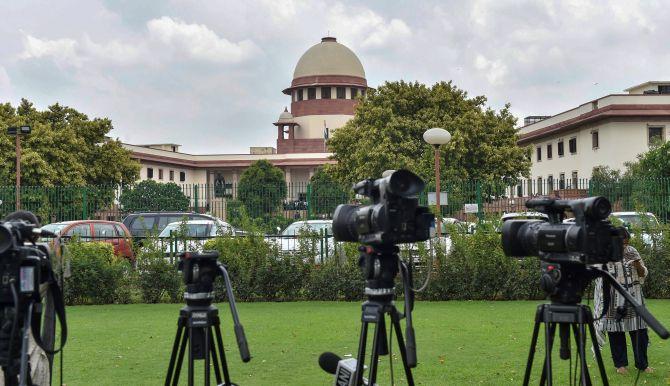India is on the brink of overhauling its tax system, implementing the BEPS project and seeing a further evolution of the GST at the same time as a general election.
This makes 2019 an exciting and challenging year, note Maulik Doshi and Jigar Doshi.

The year 2018 witnessed significant tax changes and reforms across the globe and India was no exception.
The government intensified its steps towards increasing the tax base and took further measures to crack the whip on the parallel economy.
The latter half of 2018 saw government take initial steps on reforming the Indian Income Tax Act with the formation of a committee to draft a new tax law which promises to be simple and non-adversarial.
In this backdrop, 2019 promises to be yet another year where some tax challenges will intensify, and some aspects will get simplified.
Let us look at what can we expect in 2019:
1. Direct Tax Code

The government's stated position is that it propagates a simplified and non-adversarial tax regime in India.
The current law is perceived to be complicated, lengthy, open to interpretation, and was amended several times since its inception in 1961.
From the initial attempts, it appeared that government wanted to introduce this in their current term.
However, the government had to reconstitute the task force in November 2018.
It is currently drafting new income-tax code.
It is now expected that the new code will be available in 2019.
However, when it will be implemented will primarily depend on the outcome of the forthcoming general elections.
2. Taxation of digital economy

Businesses still tend to be taxed where they have a physical rather than a virtual presence and taxation continues to be built on traditional product and service lines.
Current international tax laws have become outdated and are not in a position to tax such digital transactions.
The entire world is struggling over taxation of the digital economy and the lack of international consensus on the issue is creating uncertainty.
However, India has taken a leadership position on this, and it started by introducing the equalisation levy on online advertisements in June 2016.
The concept of significant economic presence (SEP) was introduced from April 2018 in Indian domestic law, triggering a possible tax exposure for non-residents who, though situated outside India, have a digital presence above a certain threshold that is yet-to-be-specified.
Recently, the government invited suggestions from various stakeholders for prescribing the above thresholds by August 2018.
It is expected that after considering the recommendations from stakeholders, the government will prescribe the thresholds sometime in early 2019.
The limits will decide whether only tech giants are impacted, or even mid-size companies will be under the net.
3. Critical decisions from the Supreme Court

There are certain matters which affect many corporations, especially MNCs, which are now pending before the Supreme Court.
There is a raging controversy on whether payments made overseas to non-residents/foreign companies for purchase of software could constitute payments in the nature of 'royalty'.
Over 50 appeals have been filed before the Supreme Court and the matter is now scheduled for hearing in January.
This could be a significant judicial precedent as it will bring clarity to a highly litigative subject, hopefully putting the controversy to rest.
Similarly, the issue of marketing intangibles has gained significant importance in India, where Indian subsidiaries of global multinational companies incurring advertising, marketing and promotional (AMP) expenses have been challenged by the revenue authorities.
The revenue authorities argue that AMP-related activities add value to the trademark/brand (owned by the foreign parent) by way of brand building and the local subsidiary must be compensated by the brand owner (the foreign parent) either by way of a service fee or reduced/nil royalty payments.
Indian transfer pricing regulations do not provide any specific guidelines on intangibles, other than defining them as part of 'international transactions'.
This issue is also pending for adjudication before the Supreme Court and the outcome is expected in 2019.
This will have an impact on cases of various MNCs.
4. Full-fledged electronic assessment

In previous years, the Indian revenue authorities have implemented electronic assessment on a pilot basis and then extended its reach to a large number of taxpayers.
It is now expected that e-proceedings may be implemented for all taxpayers.
This would be helpful in reducing the time and costs involved in the process and should significantly reduce the discretionary powers of the tax authorities.
However, implementation should be in the right spirit and taxpayers should not be slapped with arbitrary orders.
5. Tax notices for master file and CbCR
In line with the base erosion profit shifting (BEPS) project, India introduced enhanced transfer pricing documentation in the form of master file and country-by-country report (CbCR).
Both filings were applicable for FY 2016-2017 and the first round of audit is expected to be undertaken in 2019.
MNCs will be keen to understand the approach of the revenue authorities on these filings.
6. Budget 2019: What can be expected?

Typically, in election year an interim Budget is announced, and the newly elected government comes out with the final Budget.
News reports suggest that this year the government is proposing a full Budget in 2019.
It will be interesting to see whether it will be a populist pre-election Budget or the government sticks to the path of fiscal prudence.
7. Goods and Services Tax

The most awaited development on the GST front is the new compliance mechanism which the government is slated to introduce on an optional basis from April 1, 2019 and compulsorily from July 1, 2019.
It is anticipated that the government will take all steps to ensure smooth implementation to avoid the confusion and technological challenges faced at the time of initial stages of implementation of GST.
The government has already extended the deadline for annual return (GSTR-9) and reconciliation (GST Audit (GSTR-9C)), which will now be due by June 30, 2019, and it would be interesting to watch how taxpayers overcome the challenges, given the lack of precedent on this front.
Further, in view of GST collections falling short of the expected target, the government is expected to strengthen anti-evasion measures, such as special audits, making e-way bills robust, deploying data analytic tools and going after businesses involved in tax frauds.
With the dawn of 2019, India is on the brink of overhauling its tax system, implementing the BEPS project and seeing a further evolution of the GST at the same time as a general election. This makes 2019 an exciting and challenging year.
Maulik Doshi and Jigar Doshi are with SKP Business Consulting LLP.











